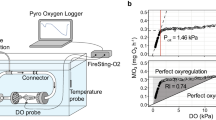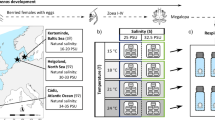Abstract
A key environmental factor that varies both spatially and temporally in surface waters is dissolved oxygen (DO). In stagnant ephemeral freshwater ponds, DO can fluctuate diurnally and seasonally, while the constant mixing of water in streams typically maintain DO levels close to saturation with only minor fluctuations. Larvae of the Near Eastern fire salamander (Salamandra infraimmaculata) develop in a range of waterbodies that vary in flow and permanence. To study inter-population variation in larval response to environmental change, we translocated larvae between stream and pond habitats and exposed larvae sampled from different habitat types to hypoxic and normoxic conditions in the laboratory. Larvae transferred from stream to pond retain gill size, while larvae transferred from pond to stream show a reduction in gill size. Larvae that were caged within their native habitat, either stream or pond, display a decrease in gill size similar to larvae transferred from pond to stream. When exposed to experimentally manipulated levels of DO in the laboratory larvae, respectively, increase and decrease gill size under hypoxic and normoxic conditions. Habitat-type origin had a significant effect on the degree of change in gill size with larvae from permanent streams demonstrating the lowest absolute variation in gill size. There was no interaction between DO level (hypoxic/normoxic) and the larvae habitat-type origin. These results suggest that S. infraimmaculata larvae are locally adapted to their aquatic breeding habitat through the plastic ability to respond to the prevailing respiratory conditions by rapidly decreasing or increasing gill size.




Similar content being viewed by others
References
Astall CA, Anderson SJ, Taylor AC (1997) Comparative studies of the branchial morphology, gill area and gill ultrastructure of some thalassinidean mud-shrimps (Crustacea: Decapoda: Thalassinidea). J Zool 241:665–688. https://doi.org/10.1111/j.1469-7998.1997.tb05740.x
ASTM (1988) Standard practice for conducting acute toxicity tests with fishes, macroinvertebrates, and amphibians. ASTM, West Conshohocken. https://doi.org/10.1520/E0729-96
Badyaev AV, Potticary AL, Morrison ES (2017) Most colorful example of genetic assimilation? Exploring the evolutionary destiny of recurrent phenotypic accommodation. Am Nat 190:266–280. https://doi.org/10.1086/692327
Bar-David S, Segev O, Peleg N, Hill N, Templeton AR, Schultz CB, Blaustein L (2007) Long-distance movements by fire salamanders (Salamandra infraimmaculata) and implications for habitat fragmentation. Isr J Ecol Evol 53:143–159. https://doi.org/10.1080/15659801.2007.10639579
Blank L, Sinai I, Bar-David S, Peleg N, Segev O, Sadeh A, Kopelman NM, Templeton AR, Merilä J, Blaustein L (2013) Genetic population structure of the endangered fire salamander (Salamandra infraimmaculata) at the southernmost extreme of its distribution. Anim Conserv 16:412–421. https://doi.org/10.1111/acv.12009
Bond AN (1960) An analysis of the response of salamander gills to changes in the oxygen concentration of the medium. Dev Biol 2:1–20. https://doi.org/10.1016/0012-1606(60)90013-0
Booth DT, Feder ME (1991) Formation of hypoxic boundary layers and their biological implications in a skin-breathing aquatic salamander, Desmognathus quadramaculatus. Physiol Zool 64:1307–1321. https://doi.org/10.1086/physzool.64.5.30156247
Boutilier RG, Stiffler DF, Toews DP (1992) Exchange of respiratory gases, ions, and water in amphibious and aquatic amphibians. In: Feder ME, Burggren WW (eds) Environmental Physiology of the Amphibians. University of Chicago Press, Chicago, pp 81–124
Branch LC, Taylor DH (1977) Physiological and behavioral responses of larval spotted salamanders (Ambystoma maculatum) to various concentrations of oxygen. Comp Biochem Physiol A Physiol 58:269–274. https://doi.org/10.1016/0300-9629(77)90383-8
Burggren WW (1984) Transition of respiratory processes during amphibian metamorphosis: from egg to adult. In: Seymour RS (ed) Respiration and metabolism of embryonic vertebrates. Junk, Dordrecht, pp 31–55. https://doi.org/10.1007/978-94-009-6536-2
Chapman LJ, Albert J, Galis F (2008) Developmental plasticity, genetic differentiation, and hypoxia-induced trade-offs in an African cichlid fish. Open Evol J 2:75–88. https://doi.org/10.2174/1874404400802010075
Davies RW, Kasserra CE (1989) Foraging activity of two species of predatory leeches exposed to active and sedentary prey. Oecologia 81:329–334. https://doi.org/10.1007/BF00377079
Dodds GS, Hisaw FL (1924) Ecological studies of aquatic insects: size of respiratory organs in relation to environmental conditions. Ecology 5:262–271. https://doi.org/10.2307/1929452
Eo SH, Doyle JM, Hale MC, Marra NJ, Ruhl JD, DeWoody JA (2012) Comparative transcriptomics and gene expression in larval tiger salamander (Ambystoma tigrinum) gill and lung tissues as revealed by pyrosequencing. Gene 492:329–338. https://doi.org/10.1016/j.gene.2011.11.018
Fritsche R, Burggren W (1996) Development of cardiovascular responses to hypoxia in larvae of the frog Xenopus laevis. Am J Physiol-Regul Integr Comp Physiol 271:R912–R917
Ghalambor CK, McKay JK, Carroll SP, Reznick DN (2007) Adaptive versus non-adaptive phenotypic plasticity and the potential for contemporary adaptation in new environments. Funct Ecol 21:394–407. https://doi.org/10.1111/j.1365-2435.2007.01283.x
Gillooly JF, Gomez JP, Mavrodiev EV, Rong Y, McLamore ES (2016) Body mass scaling of passive oxygen diffusion in endotherms and ectotherms. Proc Nat Acad Sci USA 113:5340–5345. https://doi.org/10.1073/pnas.1519617113
Gordon ND, McMahon TA, Finlayson BL, Gippel CJ, Nathan RJ (2013) Stream hydrology: an introduction for ecologists, 2nd edn. Wiley, Chichester
Hays CG (2007) Adaptive phenotypic differentiation across the intertidal gradient in the alga Silvetia compressa. Ecology 88:149–157
Hoff KS, Lannoo MJ, Wassersug RJ (1985) Kinematics of midwater prey capture by Ambystoma (Caudata: Ambystomatidae) larvae. Copeia 1985:247–251. https://doi.org/10.2307/1444824
Iwami T, Kishida O, Nishimura K (2007) Direct and indirect induction of a compensatory phenotype that alleviates the costs of an inducible defense. PLoS ONE 2(10):e1084. https://doi.org/10.1371/journal.pone.0001084
Jacob E, Drexel M, Schwerte T, Pelster B (2002) Influence of hypoxia and of hypoxemia on the development of cardiac activity in zebrafish larvae. Am J Physiol Regul Integr Comp Physiol 283:R911–R917. https://doi.org/10.1152/ajpregu.00673.2001
Jakob C, Poizat G, Veith M, Seitz A, Crivelli AJ (2003) Breeding phenology and larval distribution of amphibians in a Mediterranean pond network with unpredictable hydrology. Hydrobiologia 499:51–61. https://doi.org/10.1023/A:1026343618150
Kneitel JM (2014) Inundation timing, more than duration, affects the community structure of California vernal pool mesocosms. Hydrobiologia 732:71–83. https://doi.org/10.1007/s10750-014-1845-1
Lenormand T (2002) Gene flow and the limits to natural selection. Trends Ecol Evol 17:183–189. https://doi.org/10.1016/S0169-5347(02)02497-7
Linder G, Palmer BD, Little EE, Rowe CL, Rowe CL, Henry PF (2010) Physiological ecology of amphibians and reptiles. In: Sparling DW, Linder G, Bishop CA, Krest S (eds) Ecotoxicology of amphibians and reptiles. CRC Press, Pensacola, pp 105–166
McBurnie G, Davis J, Thompson RM, Nano C, Brim-Box J (2015) The impacts of an invasive herbivore (Camelus dromedarius) on arid zone freshwater pools: an experimental investigation of the effects of dung on macroinvertebrate colonization. J Arid Environ 113:69–76. https://doi.org/10.1016/j.jaridenv.2014.09.011
Olejnik S, Algina J (2000) Measures of effect size for comparative studies: applications, interpretations, and limitations. Contemp Educ Psychol 25:241–286. https://doi.org/10.1006/ceps.2000.1040
Pigliucci M (2005) Evolution of phenotypic plasticity: where are we going now? Trends Ecol Evol 20:481–486. https://doi.org/10.1016/j.tree.2005.06.001
Sadeh A, Truskanov N, Mangel M, Blaustein L (2011) Compensatory development and costs of plasticity: larval responses to desiccated conspecifics. PLoS ONE 6:e15602. https://doi.org/10.1371/journal.pone.0015602
Sadeh A, Polevikov A, Mangel M, Blaustein L (2015) Intercohort size structure dynamics of fire salamander larvae in ephemeral habitats: a mesocosm experiment. Oecologia 179:425–433. https://doi.org/10.1007/s00442-015-3366-7
Schneider RF, Meyer A (2017) How plasticity, genetic assimilation and cryptic genetic variation may contribute to adaptive radiations. Mol Ecol 26:330–350. https://doi.org/10.1111/mec.13880
Segev O, Mangel M, Blaustein L (2009) Deleterious effects by mosquitofish (Gambusia affinis) on the endangered fire salamander (Salamandra infraimmaculata). Anim Conserv 12:29–37. https://doi.org/10.1111/j.1469-1795.2008.00217.x
Segev O, Hill N, Templeton AR, Blaustein L (2010) Population size, structure and phenology of an endangered salamander at temporary and permanent breeding sites. J Nat Conserv 18:189–195. https://doi.org/10.1016/j.jnc.2009.08.006
Sinai I, Segev O, Weil G, Oron T, Merilä J, Templeton AR, Blaustein L, Greenbaum G, Blank L (2019) The role of landscape and history on the genetic structure of peripheral populations of the Near Eastern fire salamander, Salamandra infraimmaculata, in Northern Israel. Conserv Genet. https://doi.org/10.1007/s10592-019-01181-5
Steinfartz S, Weitere M, Tautz D (2007) Tracing the first step to speciation: ecological and genetic differentiation of a salamander population in a small forest. Mol Ecol 16:4550–4561. https://doi.org/10.1111/j.1365-294X.2007.03490.x
Templeton AR (2006) Population Genetics and Microevolutionary Theory, 1st edn. Wiley, Hoboken
Van Buskirk J (2002) A comparative test of the adaptive plasticity hypothesis: relationships between habitat and phenotype in anuran larvae. Am Nat 160:87–102. https://doi.org/10.1086/340599
Verberk CEP, Bilton DT (2013) Respiratory control in aquatic insects dictates their vulnerability to global warming. Biol Lett 9:20130473. https://doi.org/10.1098/rsbl.2013.0473
Wellborn GA, Skelly DK, Werner EE (1996) Mechanisms creating community structure across a freshwater habitat gradient. Annu Rev Ecol Syst 27:337–363. https://doi.org/10.1146/annurev
West-Eberhard MJ (1989) Phenotypic plasticity and the origins of diversity. Annu Rev Ecol Syst 20:249
Williams DD (2006) The biology of temporary waters. Oxford University Press, New York
Woods HA, Poteet MF, Hitchings PD, Brain RA, Brooks BW (2010) Conservation physiology of the Plethodontid salamanders Eurycea nana and E. sosorum: response to declining dissolved oxygen. Copeia 2010:540–553. https://doi.org/10.1643/CP-09-026
Acknowledgements
All applicable institutional and/or national guidelines for the care and use of animals were followed. Field collection of salamanders, husbandry, experimentation, and release were conducted according to the Israeli Nature and Parks Authority permits no. 2015/41087 and 2016/41511 and with accordance to the guidelines of the Animal Experimentation Ethics Committee at Haifa University, permit no. 363/15. This project was funded by the German–Israel Project-cooperation (DIP) awarded to Leon Blaustein and Alan R. Templeton (DFG reference number BL 1271/1-1), and Sebastian Steinfartz and Arne Nolte (STE 1130/8-1).
Author information
Authors and Affiliations
Contributions
OS, LB and ART formulated the idea, OS designed the experiments and developed the methodology. OS, NP and VR performed the experiments. OS and OR analyzed the data. OS wrote the manuscript; other authors provided editorial advice.
Corresponding author
Additional information
Communicated by Donovan P. German.
Rights and permissions
About this article
Cite this article
Segev, O., Pezaro, N., Rovelli, V. et al. Phenotypic plasticity and local adaptations to dissolved oxygen in larvae fire salamander (Salamandra infraimmaculata). Oecologia 190, 737–746 (2019). https://doi.org/10.1007/s00442-019-04446-5
Received:
Accepted:
Published:
Issue Date:
DOI: https://doi.org/10.1007/s00442-019-04446-5




